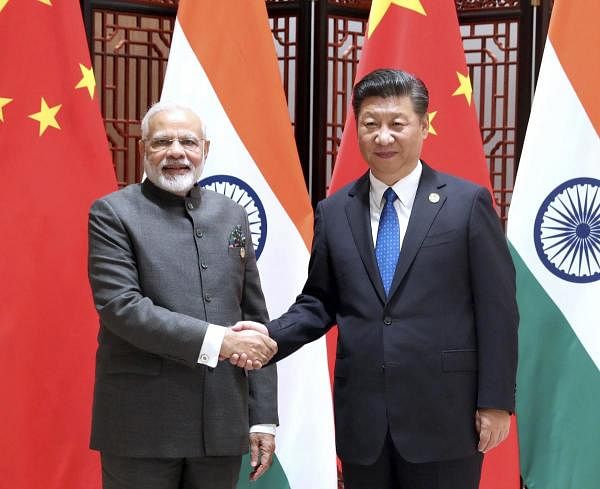
The second informal summit between Chinese President Xi Jinping and Prime Minister Narendra Modi is scheduled to take place at Mamallapuram in Tamil Nadu. The summit is expected to provide opportunities to both leaders for discussing major strategic issues in a frank and cordial manner. India’s decision to revoke Article 370 in August 2019 and China’s adverse reactions and posture in the United Nations since then provide the backdrop for this summit. However, just like the last summit at Wuhan, whether this summit will lead to any real progress remains an open question.
In 2017, India’s refusal to participate in the Belt and Road Initiative (BRI) and a prolonged military standoff at Doklam led to considerable deterioration in the bilateral relationship. Therefore, the Wuhan informal summit of April 2018 was organised to ‘reset’ the ties and arrest the deterioration.
Also read — Mamallapuram all decked up for PM Modi, Xi visit
That summit resulted in both leaders providing ‘strategic guidance’ to their militaries to maintain peace and tranquillity on the boundary. Moreover, India and China also decided to jointly implement projects in other countries. It was dubbed as the ‘2+1’ format and Afghanistan was being considered as the possible recipient of such a model. However, in the last 18 months, no progress has been reported on this count. There have also been some incidents on the border since then.
In short, the hopes of a harmonious, balanced relationship between India and China post-Wuhan have not been realised. Little has changed in the overall trajectory of the Indo-China bilateral relationship of limited co-operation and strategic competition.
That is why the argument that these summits help in building trust and mutual familiarity among the leaders needs to be questioned. China’s unsympathetic attitude and statements after India’s action in Kashmir is a clear example of the continuing disagreements and divergence of perspectives. Despite the so-called ‘Wuhan spirit’, China has not addressed India’s core concerns on the China-Pakistan Economic Corridor, membership of Nuclear Suppliers’ Group and market access for Indian goods in China. Therefore, although, the Mamallapuram summit will no doubt make for good optics for both leaders, given the past experience, it is futile to expect too much out of this summit.
In the last few years, both countries find themselves in an uncertain, difficult international setting. They both face serious trade disputes with the United States and can no longer depend on a benign international environment for their economic development. Moreover, economic growth in both countries is slowing down and therefore they hold stakes in reviving economic activity. However, India and China have divergent perspectives on the looming Regional Comprehensive Economic Partnership (RCEP). RCEP is likely to create a mega-trading block in Asia. India seems less inclined to ratify RCEP and, in fact, is worried that RCEP will further open doors for Chinese products and lead to the deterioration of an already worsening trade balance with China. It is not clear whether India’s concerns will be addressed in RCEP negotiations.
Strategic hurdles
The latest developments on the strategic front are also likely to cast a shadow over the informal summit. Recently, India had extended a line of credit worth $1 billion for the development of Russia’s far-eastern region which is expected to open doors for Indian presence in the North Pacific region. India also upgraded the Quadrilateral Security Dialogue, the Quad, to the level of foreign ministers. As Xi visits Tamil Nadu, India is holding military exercises in Arunachal Pradesh and also recently changed the status of Ladakh. These moves are likely to be on the mind of the Chinese leadership while heading for the summit. Similarly, China’s unflinching support to Pakistan, growing military presence in the Indian Ocean, latest military reforms and an aggressive rhetoric to build a ‘new China’ will not be lost on the Indian leadership.
Competition for influence in South Asian states such as Sri Lanka and Maldives will not make it any easier for India and China to accommodate each other’s concerns. Sri Lanka is heading for elections and a member of the China-friendly Rajapaksa family is in the fray. Maldives had a new government last year and India has demonstrated decisive support for the new regime. However, both countries remain heavily indebted to China and are not in a position to ignore Chinese concerns. Nepal and Bangladesh have also seen growing Chinese presence in the last few years. In fact, on his way back from India, Xi Jinping will visit Nepal on October 13, 2019, and is likely to sign agreements, including a feasibility study for railways for some projects under the BRI. It will be the first time in 23 years that a Chinese president will be visiting Nepal. In the backdrop of such strategic apprehensions, it is naive to expect that this summit will result in any real, tangible outcomes.
Also read — Modi-Xi meet: A stroll and visit to monuments
Apart from foreign and security policy issues, the domestic angle cannot be ignored as well. Initially the summit was to be organised in Varanasi in UP. However, the venue was changed to Mamallapuram in Tamil Nadu. The choice is significant in the context of the Bharatiya Janata Party’s (BJP) desire to establish its footprint in a crucial southern state. BJP has closely linked its foreign policy agenda with its domestic imperatives such as organising the BRICS summit in Goa in 2016, just before Assembly elections in the state. This summit presents an opportunity for the BJP to mark its presence in Tamil Nadu. In the context of these domestic and external factors, it is likely that this summit will not significantly alter the overall trajectory of India-China relations.
(Sankalp Gurjar is a research analyst with the Geostrategy Program of the Takshashila Institution)